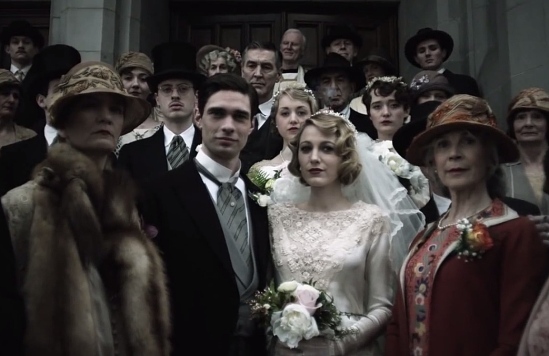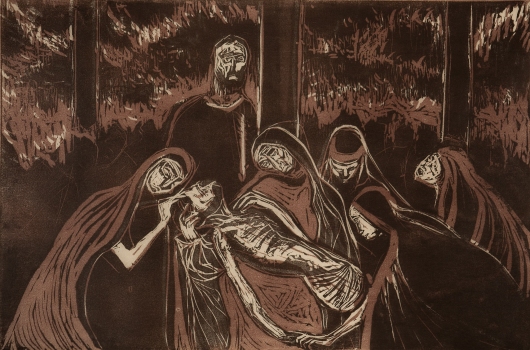 All Christian Feasts are strange–otherworldly. Perhaps no other Christian Feast is as odd as the Resurrection: we celebrate the murder of an innocent man for our sins, then Him rising from the dead and teleporting from His grave… with a super-upgraded body (it’s my theory that this strangeness of the Paschal Feast has largely prevented its commercialization by businesses, Hollywood, and government. Christmas, Halloween, St. Patrick’s Day, St. Valentine’s Day, Mardi Gras, and more, have their secularized forms… but Easter? Not so much except for the treats and stuffed animals. It just ain’t a money maker.)
All Christian Feasts are strange–otherworldly. Perhaps no other Christian Feast is as odd as the Resurrection: we celebrate the murder of an innocent man for our sins, then Him rising from the dead and teleporting from His grave… with a super-upgraded body (it’s my theory that this strangeness of the Paschal Feast has largely prevented its commercialization by businesses, Hollywood, and government. Christmas, Halloween, St. Patrick’s Day, St. Valentine’s Day, Mardi Gras, and more, have their secularized forms… but Easter? Not so much except for the treats and stuffed animals. It just ain’t a money maker.)
Combine all that with this strangest of times in world history (the pandemic quarantine), and we’ll all need a shot of what I think is the greatest of Easter hymns: O Filii et Filiae (pronounced: oh-fee-lee-ee-et-fee-lee-aye).
- King’s College’s smashing rendition:
- An epic and meditative version by Patrick Lenk:
- The hymn in its natural habitat (for Holy Mass)!
- Beautiful contemporary rendition:
—
Finally, here are the lyrics; they speak (sing?) for themselves:
| Alleluia, Alleluia, Alleluia. | Alleluia, Alleluia, Alleluia. |
| O filii et filiae,
Rex caelestis, Rex gloriae morte surrexit hodie. R. Alleluia |
Ye sons and daughters of the Lord,
the King of glory, King adored, this day Himself from death restored. R. Alleluia |
| Ex mane prima Sabbati
ad ostium monumenti accesserunt discipuli. R. Alleluia |
All in the early morning gray
went holy women on their way, to see the tomb where Jesus lay. R. Alleluia |
| Et Maria Magdalene,
et Iacobi, et Salome Venerunt corpus ungere R. Alleluia |
Of spices pure a precious store
in their pure hands these women bore, to anoint the sacred Body o’er. R. Alleluia |
| In albis sedens angelus
praedixit mulieribus: In Galilaea est Dominus. R. Alleluia |
The straight’way one in white they see,
who saith, “seek the Lord: but He is risen and gone to Galilee.” R. Alleluia |
| Et Ioannes apostolus
cucurrit Petro citius, monumento venit prius. R. Alleluia |
This they told Peter, told John;
who forthwith to the tomb are gone, but Peter is outrun by John. R. Alleluia |
| Discipulis astantibus,
in medio stetit Christus, dicens: Pax vobis omnibus. R. Alleluia |
That self-same night, while out of fear
the doors where shut, their Lord most dear to His Apostles did appear. R. Alleluia |
| Ut intellexit Didymus
quia surrexerat Iesus, remansit fere dubius. R. Alleluia |
But Thomas, when of this he heard,
was doubtful of his brethren’s word; wherefore again there comes the Lord. R. Alleluia |
| Vide Thoma, vide latus,
vide pedes, vide manus, noli esse incredulus. R. Alleluia |
“Thomas, behold my side,” saith He;
“My hands, My feet, My body see, and doubt not, but believe in Me.” R. Alleluia |
| Quando Thomas vidit Christum,
pedes, manus, latus suum, dixit: Tu es Deus meus. R. Alleluia |
When Thomas saw that wounded side,
the truth no longer he denied; “Thou art my Lord and God!” he cried. R. Alleluia |
| Beati qui non viderunt
et firmiter crediderunt; vitam aeternam habebunt. R. Alleluia |
Oh, blest are they who have not seen
their Lord and yet believe in Him! eternal life awaitheth them. R. Alleluia |
| In hoc festo sanctissimo
sit laus et iubilatio: benedicamus Domino. R. Alleluia |
Now let us praise the Lord most high,
and strive His name to magnify on this great day, through earth and sky: R. Alleluia |
| Ex quibus nos humillimas
devotas atque debitas Deo dicamus gratias. R. Alleluia |
Whose mercy ever runneth o’er;
Whom men and Angel hosts adore; to Him be glory evermore. R. Alleluia |

 Over the past few years, dozens of documentaries on the
Over the past few years, dozens of documentaries on the 

 There is a first time for everything, and this is the first Holy Smack movie review that is focused on the flaws of a film. I was not impressed by Martin Scorsese’s latest “Silence” and I cannot recommend it to anyone whose faith in Christ and His Church is not mature and convicted. This movie can be incredible violence and poison to a soul still searching for sure faith (which is most everyone).
There is a first time for everything, and this is the first Holy Smack movie review that is focused on the flaws of a film. I was not impressed by Martin Scorsese’s latest “Silence” and I cannot recommend it to anyone whose faith in Christ and His Church is not mature and convicted. This movie can be incredible violence and poison to a soul still searching for sure faith (which is most everyone).

 Last week, I viewed the newest film on Jesus: Risen, and while it did not rise to the occasion of my expectations (I had great hopes for it), I did come away with a few highlights (I try not to focus on negatives). Here’s what I mean:
Last week, I viewed the newest film on Jesus: Risen, and while it did not rise to the occasion of my expectations (I had great hopes for it), I did come away with a few highlights (I try not to focus on negatives). Here’s what I mean:

 As soon as the
As soon as the 

















 Full disclosure: I snuck out of seminary early today and went to see Cinderella alone. Being that I didn’t know what to expect, I was unsure of dragging any of my brothers along. And solo I went.
Full disclosure: I snuck out of seminary early today and went to see Cinderella alone. Being that I didn’t know what to expect, I was unsure of dragging any of my brothers along. And solo I went. —–4) As Kit is to St. Joseph, Ella is to Mary. Yes, Cinderella is very Marian. Not only do we see this in both her servant’s robes and transfigured ball gown (Marian blue!), but we see it in her humility, docility, and how she served even her enemies as a handmaid (and even accepted the name they snickered at her). We see the analogy also in how she bore her suffering, her losses and sorrow, and finally: in her ravishing beauty. Her humility is most manifest when she accepts even the lost chance of being found by Kit! I was astonished to see her content with merely keeping the mere memory of Kit in her heart, pondering and cherishing it there for the rest of her life!
—–4) As Kit is to St. Joseph, Ella is to Mary. Yes, Cinderella is very Marian. Not only do we see this in both her servant’s robes and transfigured ball gown (Marian blue!), but we see it in her humility, docility, and how she served even her enemies as a handmaid (and even accepted the name they snickered at her). We see the analogy also in how she bore her suffering, her losses and sorrow, and finally: in her ravishing beauty. Her humility is most manifest when she accepts even the lost chance of being found by Kit! I was astonished to see her content with merely keeping the mere memory of Kit in her heart, pondering and cherishing it there for the rest of her life! —–7) Also wanted to point out the indissolublity of marriage: we see the Prince deliberate intensely about it, and everyone takes it as a given that divorce is impossible. Because if divorce was possible, then marriage wouldn’t be such a big deal — just marry a substitute princess for now, and then divorce her when you find the mysterious princess! Make the King happy, the kingdom happy, and avoid all this drama. But nope. That’s not even a possibility. And our culture needs to see more examples of the
—–7) Also wanted to point out the indissolublity of marriage: we see the Prince deliberate intensely about it, and everyone takes it as a given that divorce is impossible. Because if divorce was possible, then marriage wouldn’t be such a big deal — just marry a substitute princess for now, and then divorce her when you find the mysterious princess! Make the King happy, the kingdom happy, and avoid all this drama. But nope. That’s not even a possibility. And our culture needs to see more examples of the 


 And what does a lamb symbolize in Christianity? “Agnus Dei…” which means “Lamb of God…” which means Jesus.
And what does a lamb symbolize in Christianity? “Agnus Dei…” which means “Lamb of God…” which means Jesus. ——5) What about what causes the prince in B&B to be cursed? Wouldn’t that be the sin of pride? Being spoiled, selfish, unkind… and pride causes us to be isolated to the point that we curse ourselves. Pride was the Original Sin, and it caused us to be disfigured, naked, ashamed, lonely and doomed to die. And so after the prince commits this sin, he becomes a beast: ugly, naked, ashamed, lonely, and doomed to die.
——5) What about what causes the prince in B&B to be cursed? Wouldn’t that be the sin of pride? Being spoiled, selfish, unkind… and pride causes us to be isolated to the point that we curse ourselves. Pride was the Original Sin, and it caused us to be disfigured, naked, ashamed, lonely and doomed to die. And so after the prince commits this sin, he becomes a beast: ugly, naked, ashamed, lonely, and doomed to die. ——7) And only what can redeem Beast and his servants? Only if he truly loves and is truly loved in return, right? And doesn’t Belle bear that love? She’s the one to break the spell… she must give her love to him, must give her word to him. Notice later in the film that it’s only when Belle says she loves him is the curse busted. This is so symbolic of Mary’s fiat to the Archangel Gabriel, when she said “let it be…”
——7) And only what can redeem Beast and his servants? Only if he truly loves and is truly loved in return, right? And doesn’t Belle bear that love? She’s the one to break the spell… she must give her love to him, must give her word to him. Notice later in the film that it’s only when Belle says she loves him is the curse busted. This is so symbolic of Mary’s fiat to the Archangel Gabriel, when she said “let it be…” ——9) When Gaston (whatta jerk…) attacks Beast, where does he stab him? In the side! The right side! Take a look at any crucifix and you’ll see that’s exactly where Jesus was pierced (
——9) When Gaston (whatta jerk…) attacks Beast, where does he stab him? In the side! The right side! Take a look at any crucifix and you’ll see that’s exactly where Jesus was pierced (

![[the Day when Death itself died!]](https://holysmack.files.wordpress.com/2014/04/emptytomb1.png?w=549&h=591)